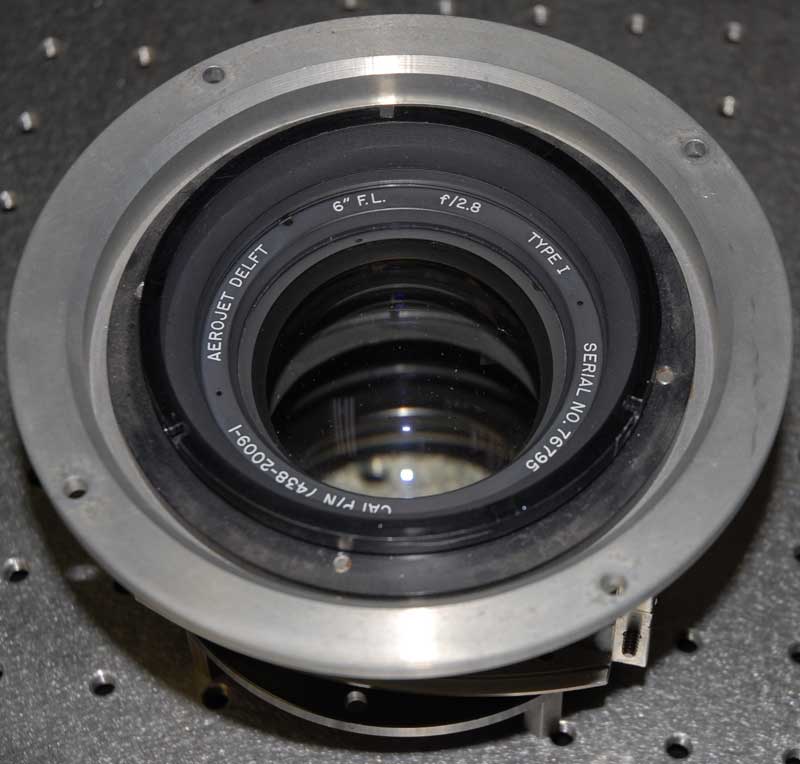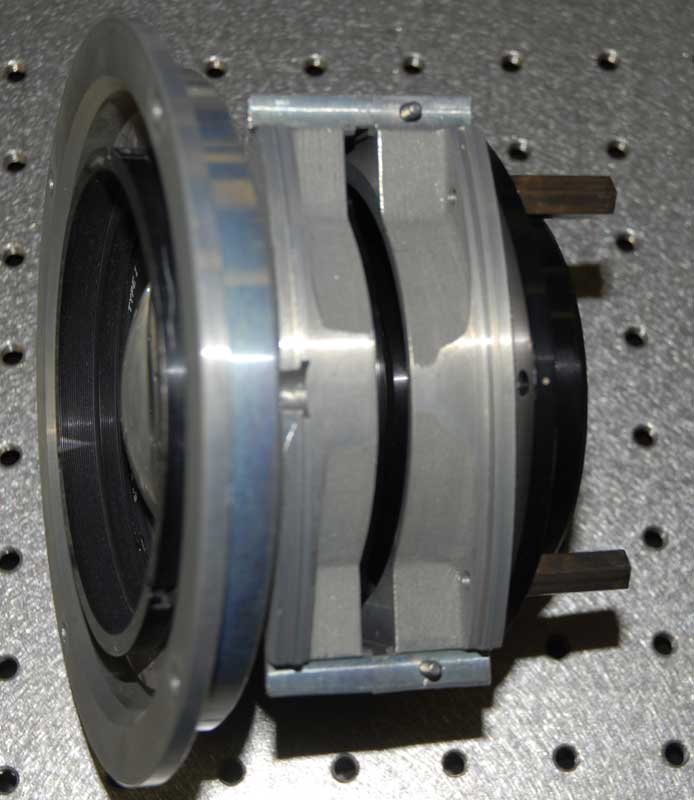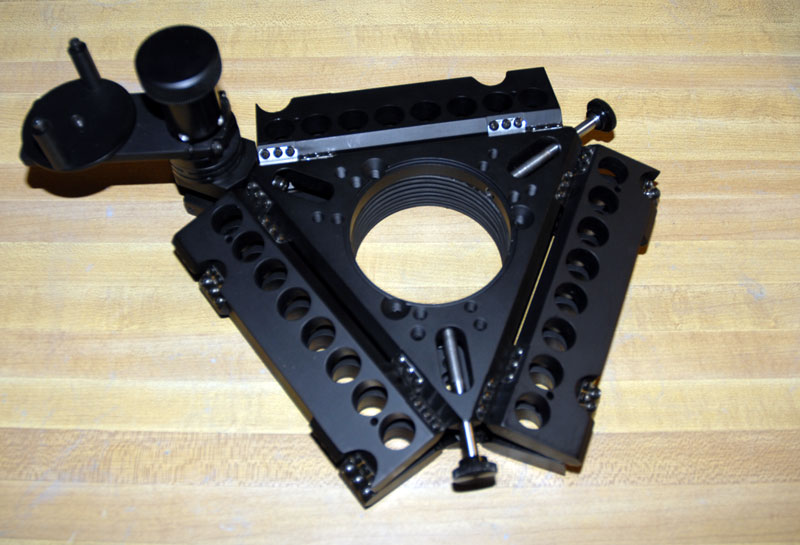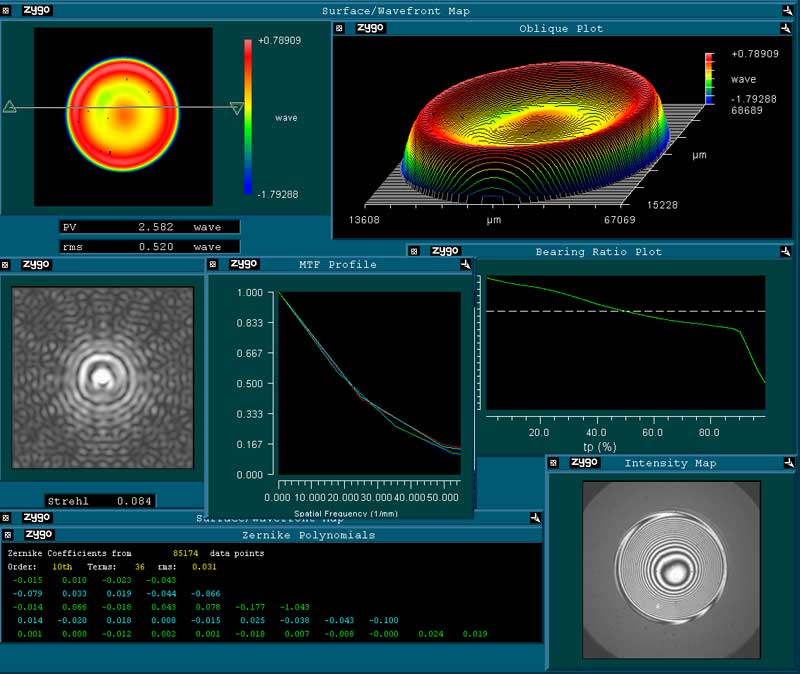

Wide Field Astrograph Project
6" Focal Length F/2.8
Dave Erickson © 2006


I thought you might find the process of evaluating, correcting, and adapting a lens system for amateur astrophotography useful. While correcting this lens will require the construction of a high order asphere pupil corrector and field corrector, this challenging project is less work than constructing an 8" F/2.6.
A few years back I purchased a 6" focal length F/2.8 aerial reconnaissance camera on the surplus market for $250. The lens itself was made by Aerojet Delft as part of a cold war era camera system manufactured by Recon Optical. These 6 element 4 group double gauss systems are corrected for yellow light. They were reported as very good when used in yellow light with 70mm photographic film. The demands of CCD astroimaging require modification of the lens to achieve peak performance. The intent is to measure the lens and design corrective optics based on those measurements.
To simplify the correction task the completed camera system will be used with color separation and band pass filters. Thus the entire visible spectrum will not be imaged at once. This requires the luminance channel will be created by taking the sum of individual RGB channels, something I do regularly. At the on set of the project it is hoped a blue spectrum corrector can be designed that is par focal with the red and green channels. But, I'll be satisfied with any solution that renders the current poor performance useful. This lens may only be useful for H-Alpha imaging.
 For this project an additional SBIG STL-11000M camera is on its way, and this system will once again use a Clement Bellerophon II focuser. This is my third Clement focuser. I received the focuser the other day and it is beautiful!
For this project an additional SBIG STL-11000M camera is on its way, and this system will once again use a Clement Bellerophon II focuser. This is my third Clement focuser. I received the focuser the other day and it is beautiful!
This project begins with testing the 6" focal length F/2.8 lens using an interferometer. The interferometer light source is a Helium Neon (HeNe) laser that operates at 632.8nm, this is close to the 656.3nm Ha line and seems a good place to start. For this test the lens is setup in an autocollimation configuration. Here the collimated beam of the interferometer enters the lens as star light would. Just beyond the lenses focus a very fast sphere is placed that reflects the light back into the lens to the interferometer. The lens and sphere share a common focus and thus are "confocal". Data is taken using a Zygo VeriFire AT™ phase measuring interferometer. Such equipment is the foundation of the precision optics industry and is becoming more available to amateur telescope makers through industry and astronomy clubs. Its use here will be familiar to advanced amateur telescope makers, and colleagues who make their living in precision optics.

From the fast astrograph narrative recall the following list of desirable astrograph properties
There are many measures of optical performance, most are provided as standard plots for the Zygo MetroPro software. From the interferogram above it is evident that the lens is not suitable for astronomical imaging even when used with monochromatic light. The Peak to Valley (PV) wavefront and RMS wavefront are more than a factor of 10 larger than diffraction limit. At first measure it looks like I wasted $250 on this lens.
Notice that there is a table of Zernike coefficients at the lower left. Terms 9, 16, 25, and 36 are various orders of spherical aberration. Term 9 is what you correct when you figured the primary mirror of your Newtonian telescope. The others are ever higher order spherical. Using these terms, optical design software, and some polishing an aspheric component can be designed and constructed that, for this wavelength, will correct the lens. You could skip the optical design software and go directly to making the asphere and use a knife edge at the lens focus instead of an interferometer to evaluate progress.
Using an interferometer provides a level of precision that is useful when correcting high slope surfaces like this lens. Small corrections from short polishing runs are easily measured and many small runs will help keep the polishing under control. This provides greater control during the figuring and helps you converge more quickly on the desired asphere. Off-axis data can be used to correct the comatic field by controlling the roll at the edge of the entrance aperture. A subaperture decentered pupil on a spherical aberrated wavefront has the "off-axis" appearance of coma, thus correcting the spherical with a strategically placed correcting element can also fix off axis coma.
With a bit of work a reflective asphere that corrects the on axis wavefront of the 6"focal length F/2.8 lens was constructed. This is intended to demonstrate that the measurements of the lens are correct and that correction of the lens is possible with the addition of an optical element placed at the lens entrance where a filter would normally reside. For the interferogram below the reflective element is used in place of the autocollimation flat and placed at the filter location in front of the lens.
It is clear from the interferogram below that a considerable improvement has been made. The on-axis performance of this lens is near diffraction limit at 633nm. Thus, the spot will be considerably smaller than the STL-11000M 9 micrometer pixel, at least for red light.

Encouraged by this result I did additional testing off axis, again using a flat mirror and an autocollimation configuration. Using the MetroPro Surface/Wavefront Profile for lens autocollimation measurements theon and off axis wavefronts were hand stitched together into single profile. Careful measurement of the size and position of the entrance aperture were made in the filter plane for each field position measurement. This way correlation of the wavefront to actual entrance aperture can be made for polishing.
Some additional RGB MTF testing of the lens using the Stevick Paul telescope as a collimator resulted in as expected very poor performance. I have decided to polish a refractive corrector that incorporates the additional aperture for the field of view and repeat the MTF measurements, hoping a simpler solution for the lenses poor color performance can be found.